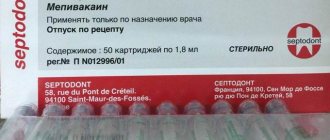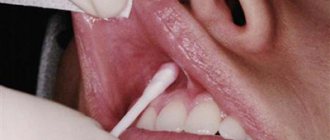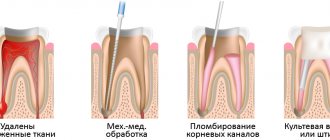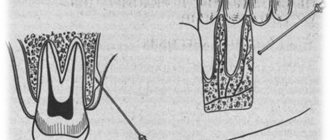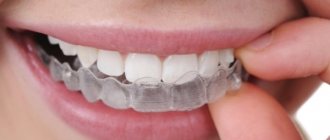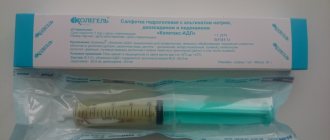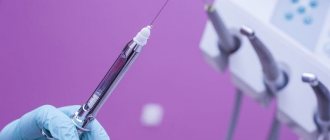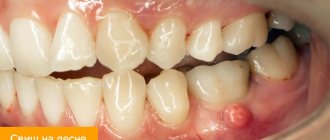Description of the drug
Scandonest without adrenaline is produced in blisters of 10 ampoules each. The drug is intended for professional use and is administered by injection into soft tissue.
Compound:
- mepivacaine hydrochloride;
- sodium hydroxide;
- sodium chloride;
- saline solution
The active ingredient of Scandonest is mepivacaine hydrochloride, the action of which is aimed at blocking the nerve impulses responsible for pain. Unlike other painkillers, Scandonest is characterized by a vasoconstrictor effect. This is radically opposite to the effect of medications that dilate the lumen of blood vessels.
Note! Scandonest is used for pain relief in patients for whom adrenaline is contraindicated.
The anesthetic effect lasts at least 30 minutes and occurs 3-4 minutes after administration of the drug. After 1.5 hours, the drug is partially eliminated from the body. However, it should be borne in mind that no more than 10% of the drug is excreted by the kidneys; the liver takes the brunt. Therefore, any pathological changes in the liver can lead to problems.
Note! When using local anesthetics, the patient remains conscious and responds adequately to the situation.
The result of using Scandonest is loss of sensitivity to pain. There is not even any unpleasant sensation. Before administering the medicine, the dentist freezes the area so that there is no discomfort during the injection. After the drug begins to act, therapy takes place in a calm environment.
Pharmacokinetics
Injected into the oral cavity through local infiltration anesthesia, mepivacaine reaches its peak concentration in the blood approximately 30 minutes after the injection. The half-life is long and is approximately 90 minutes.
Mepivacaine is metabolized quite quickly and only 5-10% is excreted unchanged in the urine. Having an amide structure, mepivacaine is not metabolized by plasma esterases. The liver is the main site of its metabolism. Any liver pathology (cirrhosis, hepatitis) leads to a general accumulation of mepivacaine.
Application in pediatric dentistry
Scandonest is used in pediatric dentistry, as it provides 100% pain relief and does not cause negative side effects. This is especially true for young patients under five years of age for whom adrenaline is contraindicated. After the age of five, children can be treated for pain with drugs containing adrenaline, for example, Ultracain DS. The dosage of the medicine corresponds to the age of the small patient.
The dentist’s work with the child should be carried out with the child’s complete trust in the doctor. After pain relief, the child gains confidence in the dentist and allows the necessary therapy to be carried out.
Why is adrenaline needed in anesthesia?
Adrenaline is a vasoconstrictor - a substance that narrows blood vessels. Therefore, on the one hand, its presence in the drug provides a longer-lasting analgesic effect, and on the other hand, it reduces the risk of bleeding during dental procedures (for example, during tooth extraction).
Given this, dentists always warn patients that anesthesia without epinephrine in dentistry has a shorter lasting effect and is not suitable for long procedures. In cases where the patient is indicated for pain relief using non-adrenaline anesthetics, treatment must be carried out very quickly or divided into stages so that the doctor has the opportunity to provide anesthesia before each subsequent stage of manipulation.
If you have a problem similar to that described in this article, be sure to contact our specialists. Don't diagnose yourself!
Why you should call us now:
- We will answer all your questions in 3 minutes
- Free consultation
- The average work experience of doctors is 12 years
- Convenient location of clinics
Single contact phone number: +7
Make an appointment
Indications and contraindications
Scandonest is widely used in dentistry for the treatment and extraction of teeth, surgical manipulations on the oral mucosa, and during operations on the jaw.
Absolute contraindications:
- intolerance to the ingredients of the drug;
- severe diseases of internal systems;
- pathology of hemoglobin formation (porphyria);
- muscle weakness (myasthenia gravis);
- children under five years of age.
Relative contraindications:
- pregnancy and breastfeeding;
- renal/liver failure;
- cardiovascular pathology;
- elderly patients over 65 years of age;
- inflammatory processes at the injection site.
The dosage of the medication depends on the age of the patient and the nature of the treatment procedures. For patients over 65 years of age, the dose of administration is half the usual dose.
Scandonest during pregnancy is prescribed with great caution after the approval of the gynecologist. The active substance is easily absorbed by the placenta and penetrates into the fetus. When feeding, you need to take into account the time it takes for the substance to be removed from the body. The active ingredients can pass into breast milk, but in small quantities.
How to improve the quality of pain relief?
A patient who is indicated for anesthesia without adrenaline in dentistry can make sure that the effect of the painkiller lasts longer and is of better quality. To do this, he only needs to follow a few general recommendations:
- Before visiting a doctor, if there is strong anxiety and fear of treatment, it is better to take a sedative, preferably based on herbs (for example, about 30 drops of valerian root tincture).
- The day before visiting the dentist, you should not drink alcohol, since alcohol in the blood weakens the effect of the anesthetic.
- If you are taking any medications or have any allergic reactions, you should inform your dentist at the treatment planning stage.
- It is better not to visit a doctor if you feel unwell or during menstruation.
Side effects
Any medicinal substance can cause negative effects of varying severity. In the case of using Scandonest, these may be reactions of different body systems.
CNS:
- drowsiness and lethargy;
- motor impairment;
- failure of tactile sensations;
- dizziness, headache;
- excessive excitability, anxiety;
- trembling of limbs;
- dilated pupils;
- loss of consciousness.
Vascular system:
- arrhythmia, tachycardia;
- decrease in pressure;
- bradycardia;
- pain in the sternum.
The patient may experience nausea and vomiting, fecal and urinary incontinence, and respiratory depression. In some cases, allergy symptoms may occur - hives, itching, rashes, swelling at the injection site. Numbness and a cold feeling at the injection site (as well as the lips and tongue) are common symptoms. Severe side effects include the patient's state of shock.
Important! The appearance of side effects requires qualified medical care.
Scandonest slows down motor reactions, so after use it is not recommended to drive a vehicle or work with equipment that requires concentration and precise movements.
Precautions
To avoid allergic reactions, it is recommended to do a test test by injecting a small volume of the drug - 5%.
Patients should not eat or chew gum until tissue sensation is fully restored. There is a certain risk of biting your lip, cheek or tongue.
What is Adrenaline
Adrenalin is a hormone of the adrenal medulla.
It is usually obtained from the adrenal gland of cattle, and also synthetically from pyrocatechol. In addition to free adrenaline, various compounds can exist in the body.
The effect of adrenaline on the body causes reactions similar to the phenomena observed during stimulation of the sympathetic nervous system, accompanied by the release of sympathins - chemical mediators (conductors) of sympathetic nerve impulses.
Adrenaline is highly active in minute concentrations.
In medical practice, a solution of hydrochloric salt of adrenaline (Adrenalinum hydrochloricum solutum) is used in a concentration of 1: 1000.
The main pharmacological effect of adrenaline is the stimulation of the sympathetic nervous system (constriction of blood vessels in almost all areas of the body, with the exception of the vessels of the lungs, increased blood pressure, relaxation of the tone of the bronchial muscles, etc.). The use of adrenaline together with anesthetic substances in surgical practice is based on its local vasoconstrictor effect.
Adrenaline itself does not have any analgesic power, but only causes, as mentioned earlier, a narrowing of small vessels and capillaries.
It should be noted that the high concentration of adrenaline used by some practitioners for conduction and infiltration anesthesia in dental practice - 1 drop (1: 1000) per 1-2 ml of novocaine solution sometimes causes unpleasant phenomena even without the solution entering the vein: heartbeat, increased pulse rate, dizziness, fainting and sometimes even collapse. Slow injection of a fresh adrenaline solution heated to body temperature significantly reduces the toxic effect of the drug.
A weaker concentration of adrenaline during conduction and infiltration anesthesia in the dentofacial area (1 drop per 5-15 ml of solution) is less likely to cause unpleasant phenomena associated with the toxicity of the substance.
There are, however, people who are very sensitive to adrenaline and even when injecting the slightest dose of it, they react with general toxic phenomena (increased pulse, palpitations, pale face and even collapse).
Many times they tried either not to use adrenaline at all, or to replace it with less toxic substances, such as eserine, ephedrine, etc. But the elimination of adrenaline led to a decrease in the analgesic effect and to an increase in the toxicity of the anesthetic.
It should only be emphasized that for pain relief, adrenaline must be added to the anesthetic substance in the weakest concentrations. For conduction anesthesia, one drop per 5-10 ml of anesthetic solution is sufficient, and for infiltration anesthesia, one drop per 10-15 ml of solution is sufficient. When it is necessary to use a large amount of anesthetic solution, take one drop of adrenaline (1: 1000) for an even larger amount of anesthetic solution (one drop per 20-25 ml).
Analogs
Analogues of the drug Scandonest contain one or more substances with identical effects. The following substitutes are used in medical practice:
- Isocaine;
- Mepivacaine;
- Mepivastezin;
- Mepidont;
- Mepicaton;
- Scandinips;
- Ultracaine DS;
- Articaine.
Isocaine
Isocaine, produced in Canada, is a local anesthetic medicine for blocking pain. The active ingredient is mepivacaine. The medicine is produced in injection ampoules intended for professional use. For local anesthesia, a 3% solution of the drug is administered, the dosage depends on the nature of the intervention.
Mepivacaine
Mepivacaine is a synonym for Scandonest, fully consistent with its composition and action. The drug is less toxic than lidocaine and also less effective. Mepivacaine is not recommended for use in patients with poor blood clotting. During soft tissue surgery, severe blood loss is possible, which can only be stopped by vasoconstrictor adrenaline. In some cases, patients are prescribed blood thinners several days before receiving Mepivacaine.
Mepivastezin
Mepivastezin is a drug for submucosal injection used in dentistry and for surgical interventions. The drug has local anesthetic and immunomodulatory effects. The active substance is mepivacaine. Mepivastezin is not recommended for use in patients with poor health or with severe kidney/liver pathologies. The drug is not recommended for use in early pregnancy due to its toxic effect on the fetus; breastfeeding can be continued one day after administration of the drug dose.
Mepidont
Mepidont is produced in Italy. This is a complex drug that contains mepivacaine and epinephrine. Epinephrine has a constricting effect on blood vessels and enhances the properties of mepivacaine. The drug is intended for professional use; prior consultation with a doctor is required before administration. Side effects are similar to other drugs based on mepivacaine, and allergic reactions are possible. Mepidont does not combine well with some medications, so on the eve of treatment the use of medications should be discontinued.
Scandinibsa
Scandinibsa, produced in Spain, based on mepivacaine, has local anesthetic properties and is administered by injection into soft tissue. Mepivacaine enhances the healing properties of other drugs that block the sensitivity of the central nervous system. Side effects occur due to sensitivity to the substances that make up the drug. In case of severe side effects syndrome, medical assistance should be provided. Eating is allowed only after the sensitivity of the nerve endings has been restored.
Ultracaine
Ultracaine is often used for treatment in the dental office. This drug does not cause significant side effects or contraindications. With the help of Ultracaine, a wide variety of dental procedures are performed, the patient does not feel pain. The drug is also used in pediatric dentistry, but after the age of four.
Important! Ultracaine is approved for use by pregnant women, but with the permission of a gynecologist.
The drug contains adrenaline, but in very small quantities. Ultracaine can be used to relieve pain in patients with high blood pressure and cardiovascular pathologies. In case of severe pain, the dosage of the drug may be increased.
Dentists give advantages to Ultracaine, which is several times greater than the effect of Lidocaine. The analgesic effect lasts a minimum of 20 minutes and can last up to 40 minutes. Ultracaine forte anesthetizes tissue within 1 hour 15 minutes.
Dosage and instructions Scandonest
Adults For ongoing interventions:
- Use 1-3 cartridges of SCANDONESTA 3% WITHOUT VASOCONTRACTOR COMPONENT, 1.8 ml per 1 intervention, depending on the area that needs to be anesthetized and the injection technique.
- In rare cases, the operation is repeated within one week on the same patient. Taking into account these 2 points, as well as the concentrations of active substances in 1 cartridge, data for which are reported by the manufacturer, the maximum doses of active substances that can be used during one visit will be as follows: - mepivacaine hydrochloride; - 1.8 ml cartridges 3x54,000 mg = 162 mg, which corresponds to 2.7 mg of mepivacaine hydrochloride per 1 kg of weight for a patient whose weight is 60 kg.
Under no circumstances should the dose exceed 300 mg per visit.
Children
The injected dose of Scandonest is determined depending on the age of the child and the degree of complexity of the intervention. The child's weight should be taken into account. The average dose is 0.025 ml of anesthetic solution per 1 kg of weight. The total dose should not exceed 1 cartridge per visit. The maximum dose of mepivacaine hydrochloride in mg that can be used in a child will be as follows: Child's weight (in kg) x 1.33.
Bottom line
Tooth extraction, removal of pulpitis and operations on soft tissues of the oral cavity should be carried out under local anesthesia. Scandonest in dentistry is a new generation anesthetic based on mepivacaine, which does not contain adrenaline. It can be administered to patients sensitive to the effects of adrenaline and who have contraindications to the use of lidocaine. This drug is also used in gynecology and in the treatment of other diseases.
Sources used:
- Solovyova A. A. (2015) Fundamentals of anesthesiology. Local and general anesthesia
- Manufacturer website Septodont (France)
- Anesthesiology and resuscitation, ed. Dolina O. A., M. GEOTAR-Media, 2006
- Bernardsky Yu. I. Fundamentals of maxillofacial surgery and surgical dentistry. - M.: Medical literature, 2000.
Anesthetics with similar effects
Analogs of Scandonest include anesthetics based on mepivacaine or other active ingredients. Among the anesthetic drugs in demand today, experts highlight the following injection solutions:
- Mepivastezin is based on the same active substance, so the indications for its use are identical to Scandonest. Allowed for use by children aged 4 years and older. Has additional immunomodulatory effects. Not recommended for patients with kidney and liver diseases, as well as pregnant women and during breastfeeding,
- "Ultracaine" is an anesthetic based on articaine, used for infiltration and conduction anesthesia. One of the most effective drugs from its group. Approved for use in children over 4 years of age,
- "Mepidont" is an anesthetic based on mepivacaine containing the vasoconstrictor epinephrine,
- "Scandinibsa" is a solution with mepivacaine as the main active ingredient. Allowed for children over 4 years of age, patients with diabetes, hypertension, heart failure and thyrotoxicosis. Suitable for patients with hypersensitivity to adrenaline.
Scandonest is a new generation of painkillers. The composition does not contain adrenaline, which has significantly expanded the range of its use. Like other modern solutions for local anesthesia, for example, based on articaine, this drug has proven itself to be an effective and safe anesthetic.
1Malamed S.F. Allergic and toxic reactions to local anesthetics, 2004.
